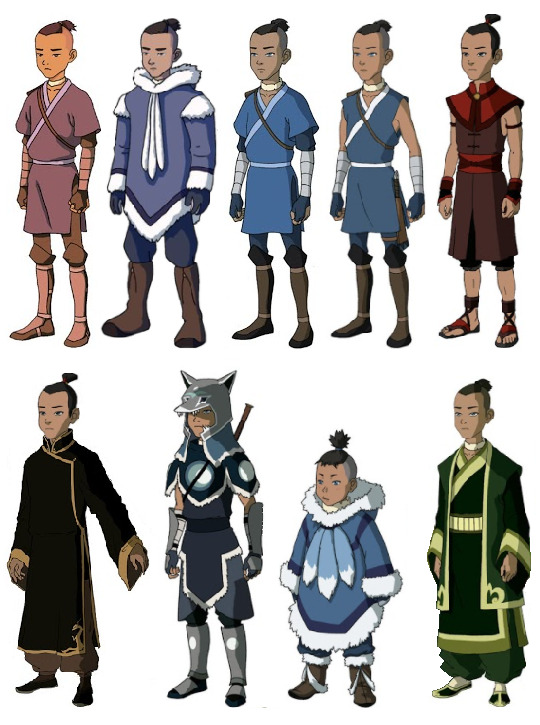Text
Cultural Architecture: NWT Totem Poles - The Specifics Pt. 1

Among most of the totem poles we see throughout the Northern Water Tribe (NWT), four representations appear consistently throughout.
Ocean & Moon
The top section of the pole has wing-like extensions jutting out, with a circle design on the actual totem. I believe that the extensions are actually stylized ocean waves and the circle represents the moon. In short, I believe the top totem represents the moon spirit and ocean spirit; by extension, the top totem also represents waterbending. Given that the NWT's society is especially dependent on bending, it makes sense that this symbolism would be represented at the very top of their totem poles.
Polar Bear
The second totem, with its wide-set face and round ears, is clearly meant to represent a polar bear. As I mentioned in a previous post: In Inuit religion, Nanook (Polar Bears) are considered to be the masters of all bears. Inuit hunters worshiped the Nanook as they believed it was the bear who determined if the hunt would be successful or not. Respect was given to Nanook by the hunter hanging the bear’s hide in a special section of his igloo, where it would stay for several days. Legend says that if a dead polar bear was treated properly by the hunter, its spirit would share the good news with other bears who would allow themselves to be hunted. Bears would stay away from hunters who failed to pay respect.
Through the second totem, we see more of the Water Tribe's Inuit influence. We also get more hints of how important hunting and respect for nature is to the culture of the NWT.
In the next post, I'll cover the significance of the koi and wolf heads, as well as the occasionally featured whale totem.
Like what I’m doing? Tips always appreciated, never expected. ^_^
https://ko-fi.com/atlaculture
71 notes
·
View notes
Text
Cultural Architecture: NWT Totem Poles - An Overview

In the Northern Water Tribe (NWT), totem poles are commonplace throughout the capitol city. According to Indigenous Foundations:
Totem poles are monuments created by First Nations [and Alaska Natives] of the Pacific Northwest to represent and commemorate ancestry, histories, people, or events... A totem pole typically features symbolic and stylized human, animal, and supernatural forms.
And the totem poles of the NWT are no different. The poles in the NWT are composed of different "segments" that likely represent animals and natural phenomenon of spiritual significance in their culture (totems).
The biggest difference between real-life totem poles and the ones depicted in ATLA are the materials used. Traditionally, real-life totem poles are carved from red cedar wood. Meanwhile, the totem poles depicted in ATLA appear to be carved/bent from ice. This makes perfect sense when considering the different resources available in the arctic versus the subarctic.
Along with bone chokers, totem poles are a type of Native American/Alaska Native/First Nation art that is well-known to most non-indigenous people, so it's not surprising that they were incorporated into the worldbuilding of the NWT.
In Part 2, I'll be covering the possible meaning/symbolism behind each of the totem pole's segments.
Like what I’m doing? Tips always appreciated, never expected. ^_^
https://ko-fi.com/atlaculture
205 notes
·
View notes
Text
Cultural Weapons: Fire Nation Swords Pt. 1
Along with covering weapons, I’m going to make another attempt at some light martial arts analysis. Like with my Kyoshi Warriors post, take it with a grain of salt as these are very superficial observations as I don’t have much IRL experience with martial arts.
Sokka & Piandao’s Swords

Both Piandao and Sokka fight using a type of Chinese sword called a jian (劍). The jian is a straight, double-edged blade as opposed to being a single-edged blade like a dao or katana. In Chinese folklore, it is known as “The Gentleman of Weapons”, which fits with warrior-scholar qualities that Piandao tries to cultivate in Sokka.
What’s most interesting about the jian is how closely-linked it is with tai chi; there are actually 32 tai chi forms that use the jian, with these forms being collectively known as taijijian (太極劍). Tai chi also happens to be the basis of waterbending.
In other words, the techniques that Piandao taught Sokka were actually taijijian forms aka sword-based waterbending moves. Secretly knowing his student was Water Tribe and might possibly be a bender, Piandao actually chose to teach Sokka techniques that would work well with waterbending as well as honoring his pupil’s culture. Which explains why Piandao’s lessons all involved learning to go with the flow and taking advantage of your surroundings, both important skills for a waterbender.
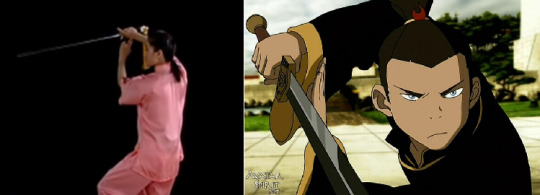
Pictured Above: Cat Stance Uppercut form. Note how Sokka’s left hand is blocking the thumb side of his sword-holding hand. According to the instructor of the video, the left arm acts as a guard to the right hand.
While typing up this post, I also realized that Katara and Sokka have mentor episodes that mirror each other. Both find the adult guidance and validation they’ve been seeking, both mentors train them in techniques that both empower them and help them to connect with their culture, and both mentors secretly want to overthrow the Fire Nation’s empire. Of course, Katara’s episode ends up a tragedy while Sokka’s is triumphant. From a thematic perspective, I suppose it’s to illustrate a healthy student-teacher relationship versus a predatory one; similar to how Iroh is set up as a loving father in contrast to Ozai’s abuse. Good lessons to teach in children’s show, actually.
Like what I’m doing? Tips always appreciated, never expected. ^_^
https://ko-fi.com/atlaculture
1K notes
·
View notes
Text
Cultural Anatomy: Katara and Sokka’s Book 1 Robes

While not entirely accurate to one culture, their robes strongly resemble Joseon-era warriors’ hanbok. Note that both Sokka and Katara’s garbs include a short-sleeved robe layered over a long-sleeve garment, a style that consistently appears in traditional warrior’s clothing in Korea. Similarly, long side slits for ease of movement and long armbands used to secure loose-fitting sleeves are present in both Water Tribe and Korean outfits.

Considering that Katara and Sokka’s original designs were streamlined for animation by Yoon Young Kim of JM Animation, it’s not surprising that their outfits draw heavily from Korean culture.
Katara’s outfit also reminds me of Hunnu Deel, Hun-Style Mongolian clothing, and Yuan Dynasty robes, the clothing of the Mongols when they ruled over China. As I dissect more of the Water Tribe’s culture, you’ll see a lot of Mongolic and Siberian influences in the clothing.
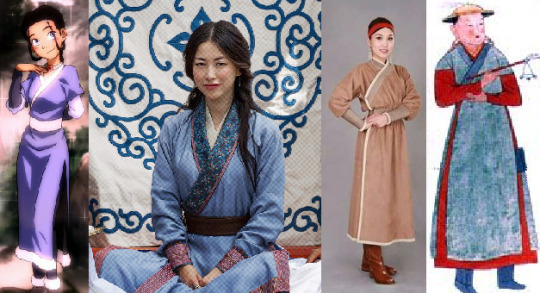
1K notes
·
View notes
Text
ATLA Martial Arts: Kyoshi Warriors
The more I learn about the Kyoshi Warriors, the more I realize that Suki really is perfect for Sokka. Like Sokka, she’s from a small and isolated village, she’s a warrior who comes from humble means, she acts as the leader of her group, and she’s skilled in various weapons and fighting styles.
First off, I just want to say that I know very little about the technical aspects of most martial arts so take these analyses with a grain of salt. These are just surface-level comparisons I’m making based off what I’ve researched on the internet. If you practice any of these martial arts, feel free to elaborate or correct me on any details.
Aikido (合気道)
According to Wikipedia, the purpose of Aikido is to defend yourself while protecting your opponent from injury. There’s an emphasis on redirecting your enemy’s force against them. Since the Kyoshi Warriors’ original purpose was to act as their island’s police, this fighting style would be very practical for stopping everyday crimes like drunken brawling or assault. Finally, the primary goal in the practice of Aikido is to overcome oneself instead of cultivating aggressiveness, which is essentially the lesson Sokka takes away from his training sessions with Suki.
From what I’ve observed, Aikido emphasizes wide-legged stances, wrist/shoulder grabs, and lots of throws. The rare times when kicks are used, they’re low kicks done for the purpose of knocking an opponent off-balance. Also, the hakama bottoms that the Kyoshi Warriors wear are commonly associated with the martial art of Aikido. Some montages of Suki’s most recognizably Aikido moves:
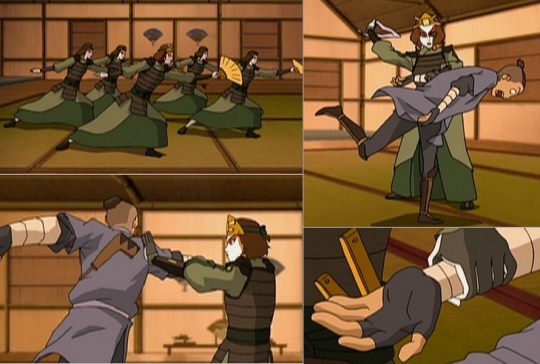
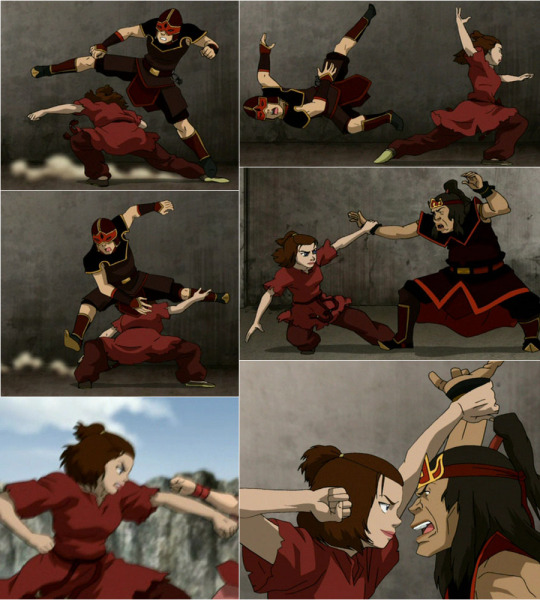
Tessenjutsu (鉄扇術)
Tessenjutsu or “iron fan technique” is the martial art of the Japanese iron fan (tessen). They were most famously used by samurai to fend off swords, throwing knives, and poisoned darts. In the case of the show, the fans were shown to be capable of blocking fireballs. Like a sword, the tessen could be dual-wielded to parry with one hand and attack with the other.

Kendo (剣道)
Kendo or “way of the sword” is a modern Japanese martial art descended from traditional swordsmanship (kenjutsu or “sword technique”). Since the Kyoshi Warriors employ “modern” hand-to-hand combat techniques (Aikido), I think it’s safe to assume they probably also use modernized Japanese swordplay. Logistically, Bryke would have had an easier time finding an English-speaking kendo expert than a practitioner of an ancient sword style like Kashima Shinden Jikishinkage-ryū, for example.
Anyways, when Suki fights Azula, she attempts to land a Kendo-style strike to the throat. Her use of that technique might actually be a reference on her own name; the Japanese word for this attack is morote-zuki (諸手突き), which roughly translates to “two-handed thrust”.
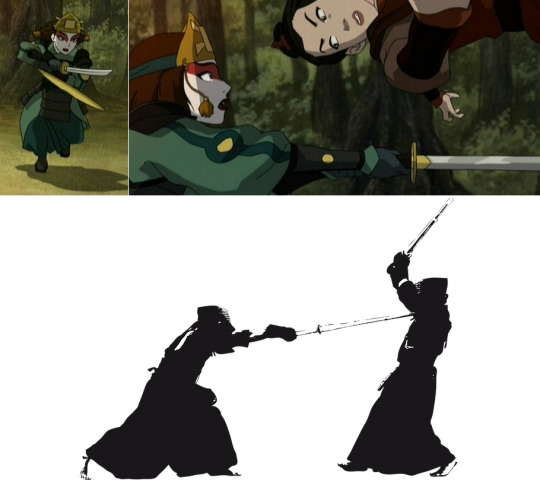
The Kyoshi Warriors are like the Swiss Army knife of fighters in the Avatarverse.
2K notes
·
View notes
Text
Cultural Anatomy: Kyoshi Warriors Uniform

As mentioned in a previous post, the leader of the Kyoshi Warriors (Suki) sports a maetengan (前天冠) or “heavenly crown” with a decorative maedate (前立) or “front crest”. The other Kyoshi Warriors wear hachigane (鉢金) or “metal-plated forehead protectors” decorated with maedate. If you’d like a example pictures and a more in-depth description, click here.
The Kyoshi Warriors’ fabric clothing are comprised of a bright green kimono/着物 (Japanese robe), dark green hakama/袴 (traditional Japanese trousers), an obi/帯 (sash), and han kote/籠手 (Japanese vambraces).
Over their green kimonos, the Kyoshi Warriors wear hara-ate dō (腹当胴) or “torso armor”. The type of armor they wear is notable as it was initially worn only by ashigaru (足軽) or Japanese foot soldiers. Ashigaru armor is unique for its single-piece, barrel-like torso armor, in contrast to the elaborately plated lamellar-style armor that samurai wore.
The advantages of ashigaru armor was that it was lighter and easier to move around in, as well as being much cheaper to produce. In contrast, samurai armor offered better protection at the cost of speed and agility, which was less of an issue for the horse-riding samurai class. However, the effectiveness of ashigaru armor resulted in many later samurai trading in their fantastically stylish armor for the streamlined and practical ashigaru-style armor.
I bring this up because ashigaru armor fits the Kyoshi Warriors’ sensibilities perfectly. Their style of fighting emphasizes agility and momentum, which ashigaru allows for. Secondly, it emphasizes that the Kyoshi Warriors are very humble people. Ashigaru (foot soldiers) were everyday citizens (mostly farmers) who were conscripted into battle, not high-ranking nobility swearing allegiance to a powerful warlord. Kyoshi Island is a tiny, isolated island made up of small villages so it would have no need for fancy lords or a hereditary warrior class. The Kyoshi Warriors are likely just local girls who volunteered to be trained. This would also explain why the Kyoshi Warriors seem to be pretty open to showing outsiders (Sokka & Ty Lee) their techniques; they’ll teach anyone whose willing.
1K notes
·
View notes
Text
youtube
Not really ATLAculture related, but this is one of my favorite documentaries on YouTube. A pretty extensive overview of marriage practices in different regions and groups in China.
92 notes
·
View notes
Text
Cultural Fashion: Hair Loopies
Dissecting the real life cultures that influenced show. First up is Katara’s trademark ‘do!
Hair Loopies
So this first fact actually comes from the Twitter poster, Low Arctic (https://twitter.com/LowArctic). The reference pictures used are screenshots from Atanarjuat: The Fast Runner (Inuktitut: ᐊᑕᓈᕐᔪᐊᑦ).
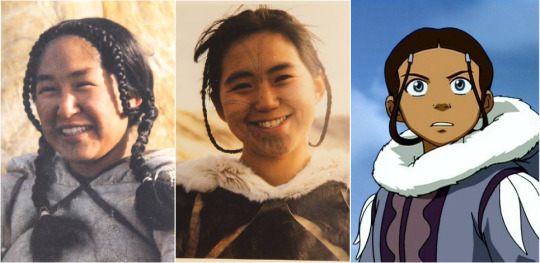
While braided hair is common in many cultures, Katara’s trademark “hair loopies” are uniquely Nunavut Inuit. According to Tumblr user Atagotiak, who is of Inuk descent, hair loopies are known as qilliqti in Inuktitut. While her “loopies” are drawn un-braided in the show for ease of animation, I’d love to see them thinly braided and decorated with bright blue beads in the live-action adaption.
Here is another examples of qilliqti or “hair loopies” in real life and Avatar:
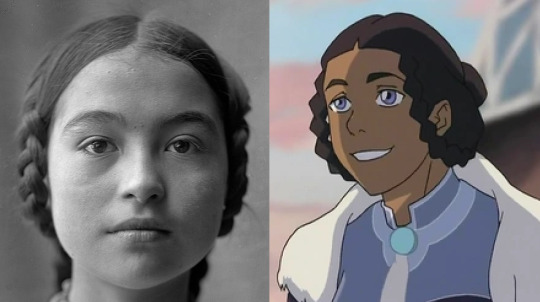
The young woman photographed is Nancy Columbia, an Inuit-American beauty queen, actress, and screenwriter from the Silent Film Era. When I try to imagine Katara as a real person, she ends up looking a lot like Nancy.
Like what I’m doing? Tips always appreciated, never expected. ^_^
https://ko-fi.com/atlaculture
4K notes
·
View notes
Text
Quick Life Update
A couple of years ago, I mentioned that I work at a prison. Well, today they've announced that the prison is officially shutting down. We're currently in the process of trying to pack out and transfer 600+ inmates into other prisons before the end of the week.
I'm not sure whether this is a permanent shut down or if the prison is going to be re-modeled for a "mission change"--- this is when a prison's inmate population changes in accordance with a lower or higher security level. They haven't given us any more information, unfortunately.
So if you're wondering why I haven't been posting as much lately, it's due to the stress of my workplace making a lot of changes very quickly. If it turns out that my place of employment will be no more, then expect a lot more ATLAculture posts in the future as I sort out my life trajectory.
And if you know any jobs that require an archivist, freelance researcher, freelance writer, teacher, systems administrator or prison guard, send the listing my way.
116 notes
·
View notes
Text
Happy New Year!
Happy Theravada Buddhist New Year Everyone! May peace and good fortune be upon you.
72 notes
·
View notes
Text
Cultural Fashion: The Painted Lady Hat
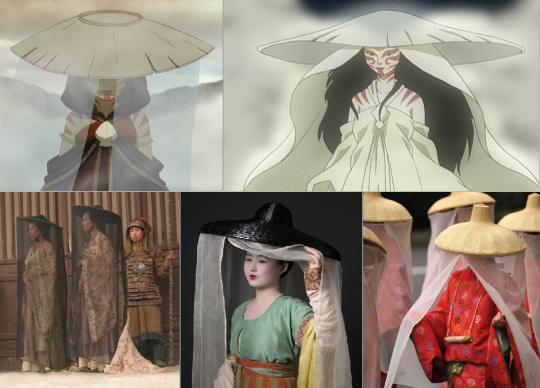
The hat that the Painted Lady, both real and fake, wears is known as a mìlí (幂蓠) in Mandarin Chinese and an ichimegasa (市女笠) in Japanese. Both refer to a woven, wide-brimmed hat with a body-covering veil attached. The style originated from the nomadic steppe people of Northwest Asia and was later adopted by Chinese culture during the Sui Dynasty (581–618) and introduced to Japan during the Tang Dynasty (618-907).
The hat was mostly worn by women of noble or aristocratic birth in both China and Japan. In China, the hat was especially popular among the ladies of nobility who rode horses on the public roads. The purpose of the hat became both practical and cultural: the veil shielded noblewomen from outdoor elements such as insects and dust, but it was also viewed as protecting their “modesty” from the outside world.
If this context also holds true in Avatar, the Painted Lady might have been a local aristocrat who provided aid to Jang Hui Village before passing on. The way she’s briefly presented in the episode is also very similar to Yue (long flowing white dress with anime-style detached sleeves), which leads me to think she was also once a human woman.
Maybe the body paint she wore was meant to mask her identity when she did her charity? A local person of status winning over the common people might have been seen as a direct threat to the Fire Lord’s national hegemony, especially since the village seems to have basically deified her. My pet theory is that the arms factory polluting their village was purposely set up there as punishment for their perceived loyalty towards the Painted Lady’s legacy over the Fire Lord’s cult of personality.
Like what I’m doing? Tips always appreciated, never expected. ^_^
https://ko-fi.com/atlaculture
2K notes
·
View notes
Photo





Avatar World Tour: The Southern Water Tribe
Starting a new post series in which I highlight some of the best background art and establishing shots in the show by location. The top row features the SWT at different points in time:
1. Hama’s youth, roughly ~60 years prior to the story
2. The day Sokka and Katara lost their mother, 6 years prior to the story
3. The day Aang awakened
The three images in succession paint a stark narrative of loss and displacement. What stands out most to me is the increase in tupiqs (animal skin tents) and decrease in igloos with each picture. It reflects a pretty steep population decline as an igloo requires more labor to set up than a tupiq, especially without waterbenders. It might also reflect how the war has shaped the SWT’s culture over the past ~60 years, with families favoring the more portable tupiq over the more immobile igloo due to the constant threat of raids from the Fire Nation.
1K notes
·
View notes
Text
Avatar Closet: Katara
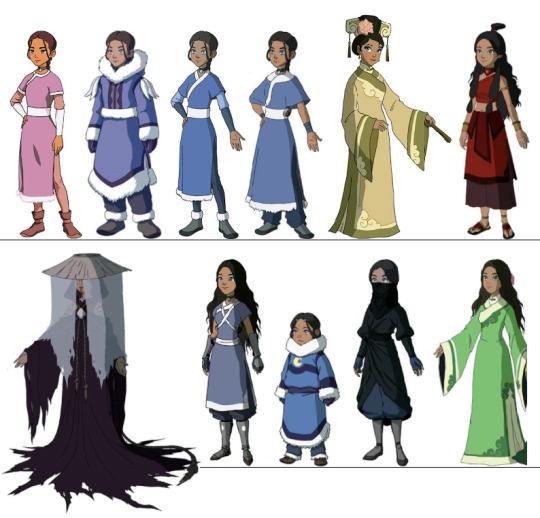
Fun fact, Katara’s final scene dress is just her pretend-rich-girl dress from S2 in green.
1K notes
·
View notes
Text
Cultural Anatomy: Katara’s Book 2 Outfit

Katara’a Book 2 dress intrigued me in how uncanny it was to her Book 1 dress. The small changes they made to it completely changed the cultural vibes I was getting. The Book 1 dress just felt innately East Asian; the cross collars, sash, column skirt with high slits, and armbands created the image of a stereotypical martial artist.
When I look at her Book 2 dress, the rounded collar and A-line skirt felt a bit European to me. The rounded collar that buttoned up at the side reminded me of a Kosovorotka (Russian Peasant Shirt), so I figured Eastern Russia (Siberia) would be a good place to start researching.
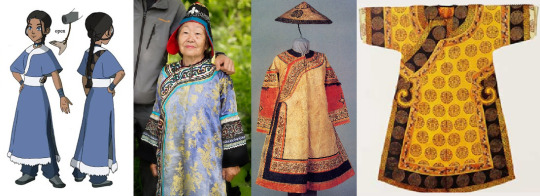
And, with a little digging, I found a pretty spot on inspiration for Book 2 Katara: Tungusic Clothing. The Tungusic people are an ethnolinguistic group formed by the speakers of Tungusic languages; these ethnic groups include the Nanai, the Oroch, and the Manchu, whose clothes are featured above. They are native to Siberia and Northeast Asia.
Katara’s dress is just a Tungusic robe with the lower sleeves and cuffs removed. The loose sleeves, A-line silhouette, side slits, and rounded collar with thick trim are all typical of many traditional Tungusic outfits. A sash was added because pretty much every outfit in the Avatar-verse has a cinched waist. I like to think that Katara got this outfit from the Northern Water Tribe, since they have quite a bit of Siberian and Mongolic influence.
1K notes
·
View notes
Text
Cultural Anatomy: Southern Water Tribe Coats
The coats that the Southern Water Tribe wears are commonly known in English as parkas. A parka is a a cold-weather coat that is typically hip-length or longer, stuffed with down, and possessing a fur-lined hood. Parkas are traditionally worn by various Arctic peoples, such as the Inuit/Iñupiat and Yup’ik.
The parkas that Katara and Sokka wear appear to based on traditional Yup’ik and Iñupiat coats, respectively. Note the similar silhouettes, the distinctive fur lining on the sleeve seams, the curved hems with side slits for the legs, and the fur lining around the waist of Katara’s jacket.
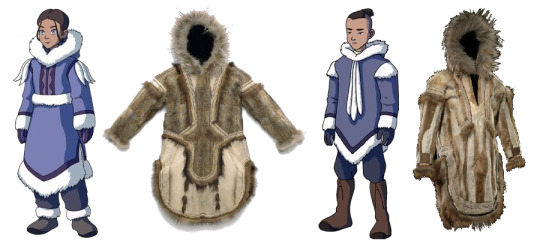
The parka that Gran-Gran wears appears to be based off an Akulik Amauti, a baby-carrying coat worn by the Inuit women of Nunavut. Note the extra baggy hood, the straps over the chest, and the straight hem at the bottom of the jacket. It’s an appropriate jacket for a woman who helped raise two generations of children.
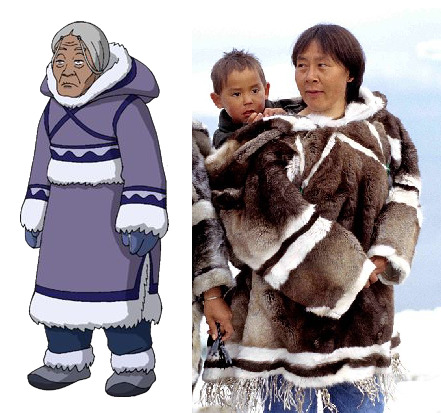
Mike and Bryan have also confirmed that the overall aesthetic of the Southern Water Tribe is based off the Inuit film “Atanarjuat: The Fast Runner” (2001), which is steeped in the culture of Nunavut Inuit.
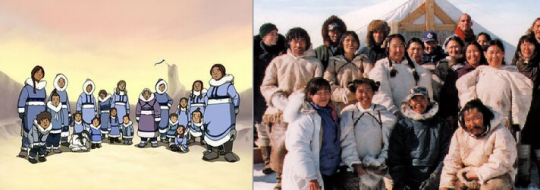
2K notes
·
View notes
Text
Cultural Anatomy: Water Tribe Boats Pt. 1
Hold on tight, because this is going to be a monster of a post.

The boat that Sokka and Katara were on before finding Aang is called an umiak or anyak. Umiak are traditional Inuit/Inupiat and Yupik open skin boats that are used throughout the arctic, from Siberia to Greenland. Here’s a short description of the traditional umiak-making process:
A traditional umiak begins with a frame built from driftwood, whalebone, or a combination of both. The frame is pegged and tied together with sinew, and skin from a walrus or seal is stretched over it. Most umiak require multiple skins to be sewn together to create the boat’s buoyant exterior. Oil is added on to coat and waterproof the seams. Finally, the newly skinned and oiled umiak is placed out into the wind and cold to dry.
These details all match up perfectly with what we see of Sokka and Katara’s boat. For example, their vessel clearly uses a combination of bone and wood in its framework. The “spine” of the frame clearly uses some sort of bone— if I had to guess, I’d say it’s a part of a whale’s jawbone— while the ribbing, rim, and seats of the umiak are made of wood. You’ll also notice that there’s plentiful roping and tying on the boat (around the bone, along the rim of the boat, on the seat planks, etc.), as traditional umiaks are not put together using nails or bolts.
The meta of them hunting using an umiak is also interesting as well. In many Inuit cultures, primarily those residing in the Eastern Arctic (northeast Canada), the umiak is considered “a woman’s boat”. As the umiak was rarely used for fishing, its main purpose was to provide transportation for women and children, while the men primarily used kayaks. When a man was on board of an umiak, he was generally expected to do the steering.
When we first meet Sokka and Katara, they’re trying to spear fish aboard an umiak. This is not a traditional hunting arrangement. Under normal circumstances, Sokka would be hunting in a sleek and agile kayak alongside the men of his village. So where did the kayaks go? They were probably all taken by the men for the war effort. In turn, Sokka is forced to improvise and learn to hunt with neither the proper tools nor guidance; which builds on Avatar’s recurring theme of war forcing children to essentially raise themselves with less-than-stellar results.
Similarly, when the siblings run into some ice floes, Sokka is the one prepared to steer the boat by positioning himself at the front. He tries his best to guide the boat as his father would, but it really is unreasonable to expect an unsupervised 15-year-old to steer a boat with a passenger around such sharp turns.
The umiak being considered a “woman’s boat” also explains why Sokka even brought Katara fishing with him in the first place, despite his rather narrow idea of “women’s work”. It’s very likely that the umiak was sewn together by Katara and Gran-Gran to help transport the village’s women and children, meaning that Sokka was essentially borrowing Katara’s boat. It would also explain why the decorations on the boat look like designs Katara would think to put on it; the purple waves on the boat match the design on the front of her parka and the crescent moon is obviously in reference to her waterbending.
This also provides even more reason for Katara to be angry at him after his “leave it to a girl…” comment. Imagine your brother borrowing your car— which you designed and built with your grandmother— and then crashing it while you’re riding with him, only for him to turn around and blame it all on you!
I think anyone would be angry enough to break icebergs after that.
Like what I’m doing? Tips always appreciated, never expected. ^_^
https://ko-fi.com/atlaculture
3K notes
·
View notes
